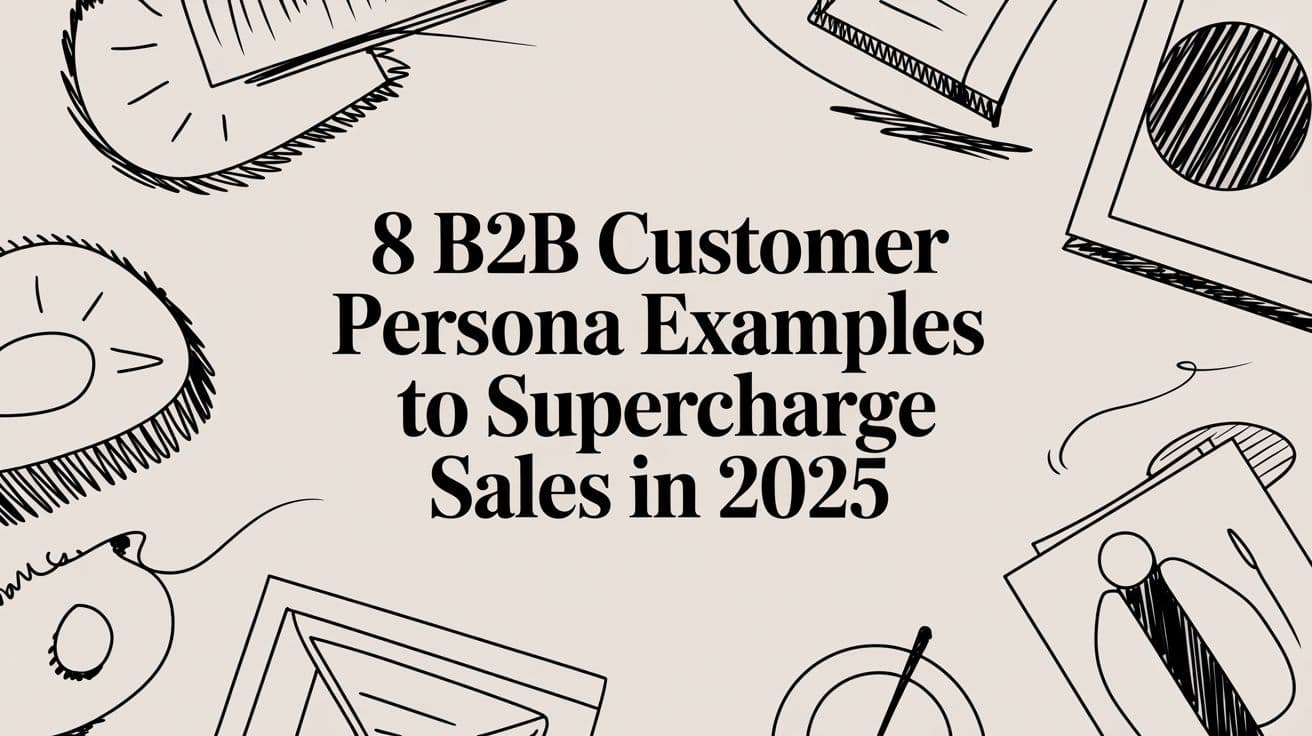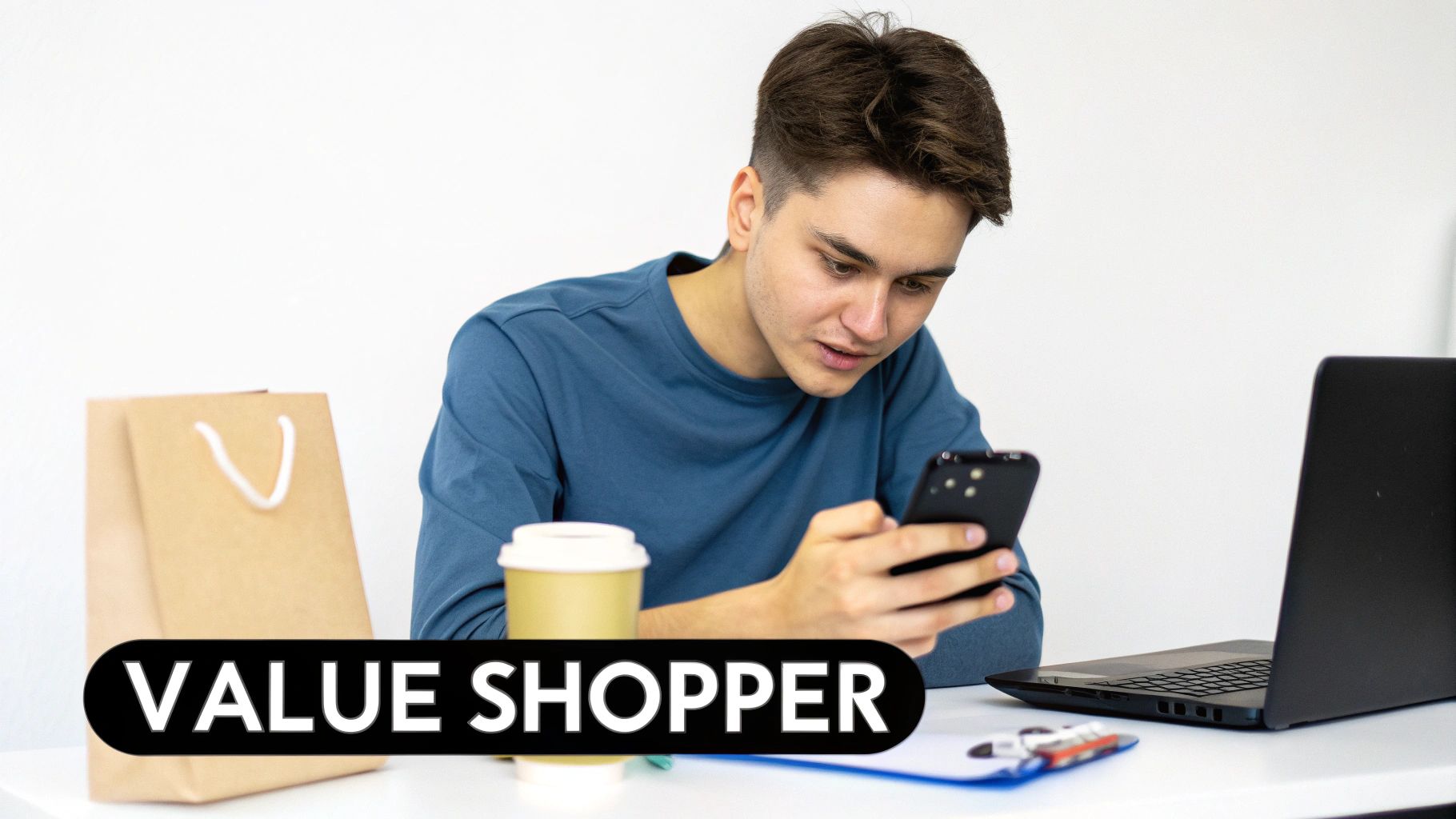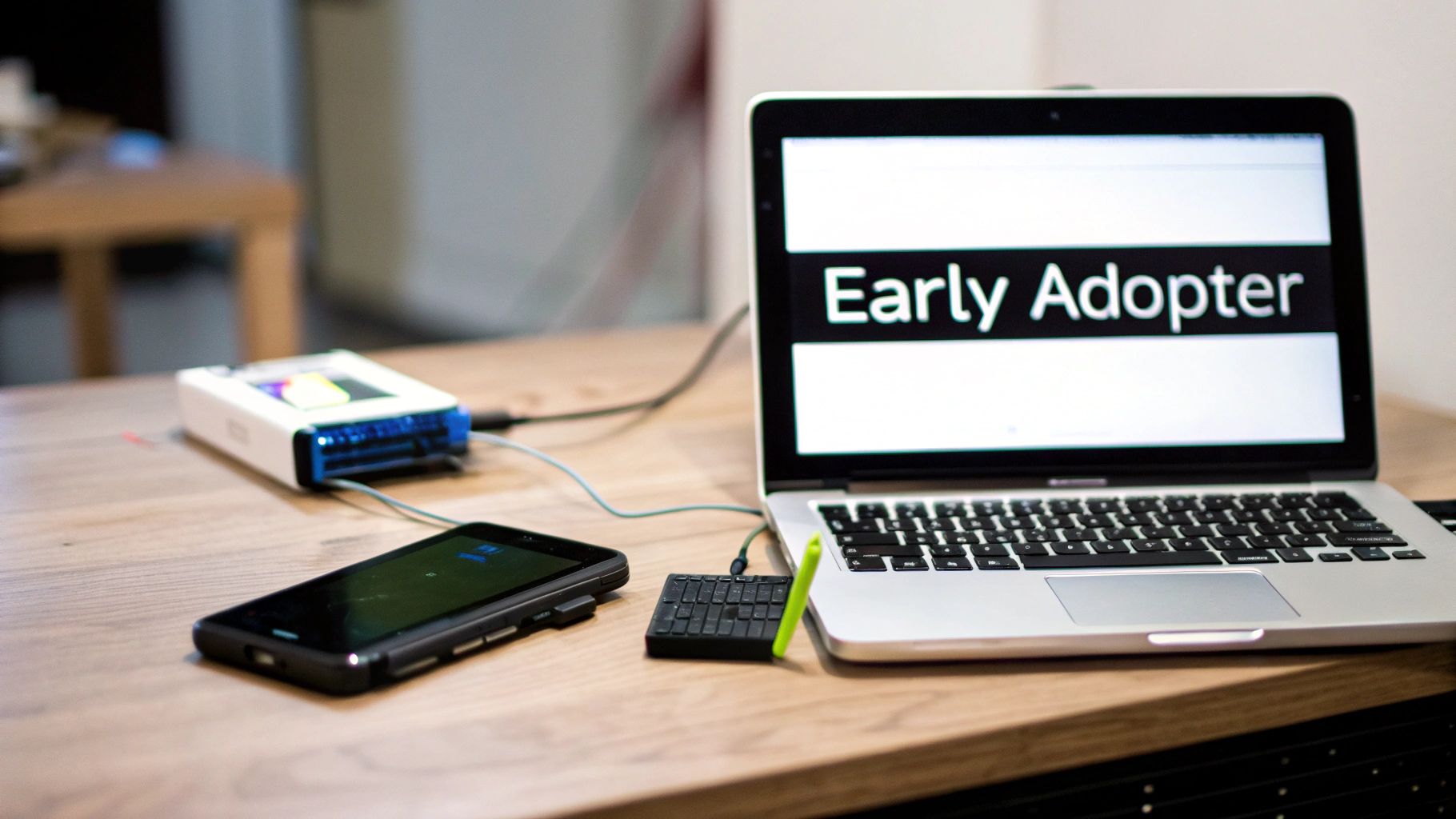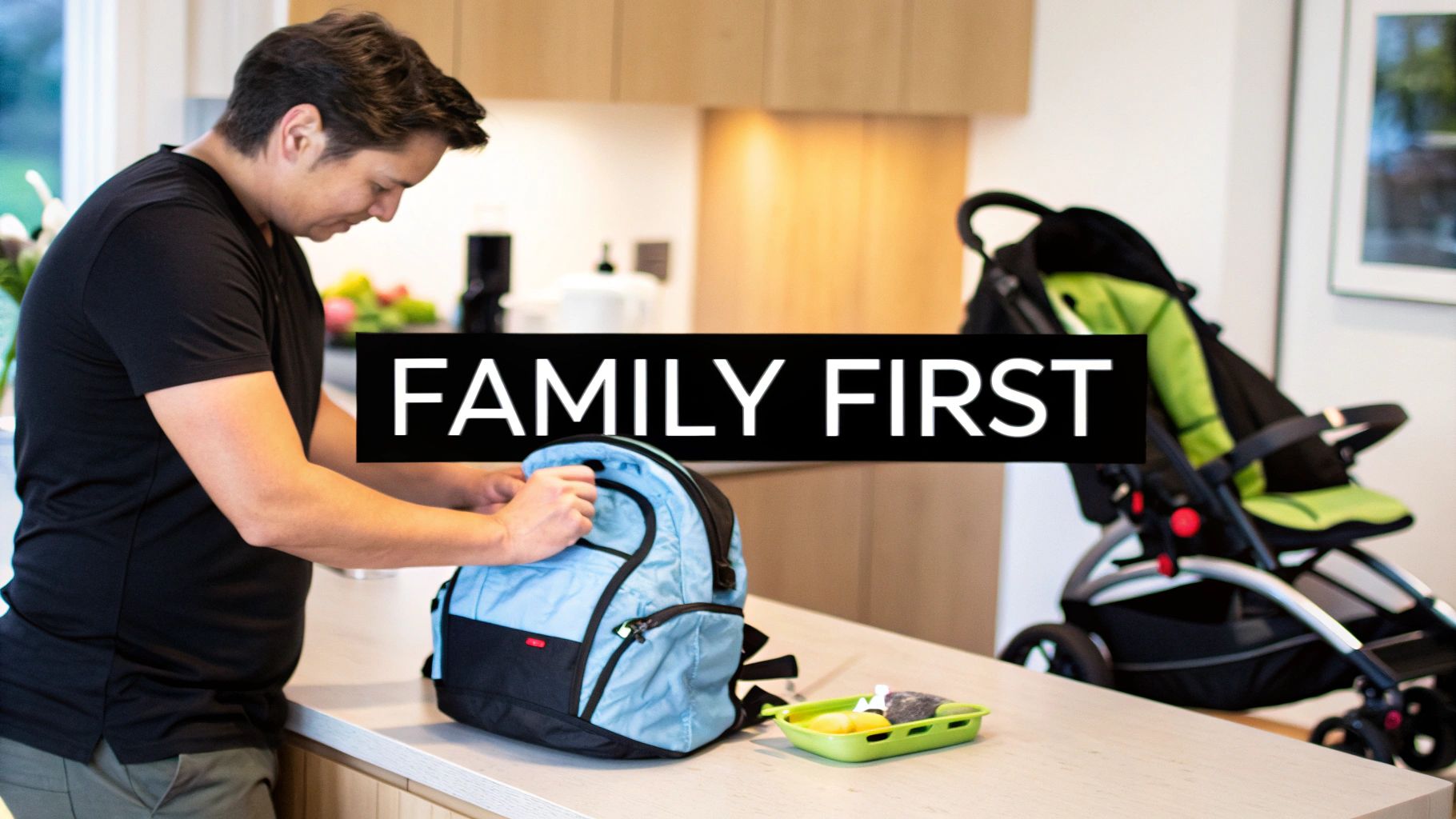8 B2B Customer Persona Examples to Supercharge Sales in 2025
November 26, 2025

Generic, one-size-fits-all personas are the silent killers of a B2B sales pipeline. They lead to vague messaging, low response rates, and ultimately, wasted resources. When your team doesn't have a crystal-clear picture of who they're selling to, every outreach email and LinkedIn message feels like a shot in the dark. This is why a detailed customer persona example isn't just a "nice-to-have" marketing asset; it's a critical sales tool that drives targeted, effective communication. Moving beyond basic demographics to understand a prospect's deep-seated goals, daily frustrations, and specific buying triggers is what separates a deleted email from a booked demo.
This article cuts straight to the chase. We provide a curated collection of actionable B2B customer persona examples, complete with templates and strategic breakdowns. Before you can craft these detailed profiles, you need a solid foundation. The process starts with correctly identifying your target audience to ensure your personas are based on data, not assumptions.
For each persona, you will learn how to translate their profile into personalized outbound messaging that resonates. We'll break down how to craft compelling subject lines and LinkedIn hooks tailored for sales automation, turning abstract data into tangible pipeline. Forget theory; this is your practical playbook for building personas that actually convert.
1. Busy Professional (B2B SaaS Persona)
The "Busy Professional" is a foundational B2B customer persona example, representing a mid-to-senior level manager or executive at a scaling company. This individual is perpetually short on time and highly focused on outcomes, making them a key decision-maker for solutions that promise efficiency and a strong return on investment.
This persona, typically aged 35-55, isn’t just looking for another tool; they are seeking a strategic advantage. Their primary pain point is a lack of time and resources to manage growing operational complexity. They need solutions that slot into their existing tech stack without a steep learning curve or extensive team training.
Strategic Breakdown
Companies like HubSpot, Salesforce, and Slack excel at targeting this persona. HubSpot attracts project managers by automating marketing tasks, directly addressing the need to do more with less. Slack's entire value proposition is built around reducing internal email clutter and streamlining communication, a clear win for overloaded teams.
The common thread is a focus on immediate value and seamless integration. These brands don't sell features; they sell saved hours and simplified workflows.
Actionable Outbound Strategy with Roger
When targeting the Busy Professional, your outreach must be concise and value-driven. Long, feature-heavy emails will be ignored.
How to personalize your messaging:
- Lead with ROI: Start with a clear, quantifiable benefit. Instead of "Our tool helps teams collaborate," try "Save your team 10 hours per week on project updates."
- Highlight Integration: Mention specific tools they already use (e.g., "integrates with Salesforce and Slack in two clicks").
- Minimize Friction: Offer a demo that takes "15 minutes, not 60" or a free trial with zero setup required.
Sample Subject Lines & LinkedIn Hooks:
- Subject: 10 mins to cut your team's reporting time by 50%?
- Subject: Quick question re: [Their Company]'s tech stack
- LinkedIn Hook: Saw you're using [Tool X]. What if you could connect it to [Your Tool Category] and automate [Specific Task]?
2. Cost-Conscious Millennial (E-commerce Persona)
The "Cost-Conscious Millennial" is a crucial e-commerce customer persona example, representing consumers aged 25-40 who are digital natives. This persona is defined by their extensive pre-purchase research, high price sensitivity, and a strong desire for value, which extends beyond just the lowest price to include factors like sustainability and brand ethics.
This individual is not making impulse buys; they are methodical shoppers who compare prices across multiple platforms, read reviews, and seek social proof before committing. Their primary pain point is feeling like they are overpaying or buying from a brand that doesn't align with their values. They want transparent pricing, ethical sourcing, and a seamless online shopping experience.

Strategic Breakdown
Brands like Warby Parker, Allbirds, and ASOS have masterfully captured this persona. Warby Parker disrupts the traditional eyewear market with transparent, affordable pricing and a home try-on model, directly addressing the fear of overpaying. Allbirds connects with the persona’s values by emphasizing sustainable materials and ethical manufacturing, justifying its price point through a different kind of value.
The common thread is a blend of transparent value and authentic brand storytelling. These companies don't just sell products; they sell a smarter, more conscious way to shop.
Actionable Outbound Strategy with Roger
When marketing to the Cost-Conscious Millennial, your outreach must be authentic, visually engaging, and highlight clear value. Hard-sell tactics or generic ads will be quickly dismissed.
How to personalize your messaging:
- Lead with Value: Frame offers around savings, quality, or ethical benefits. Instead of "New shoes available," try "Sustainable shoes made to last, with free shipping."
- Leverage Social Proof: Feature user-generated content, reviews, and micro-influencer collaborations prominently in your messaging and ads.
- Promote Transparency: Clearly state your pricing, return policy, and sustainability practices. No hidden fees or vague promises.
Sample Subject Lines & LinkedIn Hooks:
- Subject: 15% off your first order + free shipping over $50
- Subject: See how [Your Brand] is making fashion sustainable
- LinkedIn Hook: Tired of fast fashion? We create [Your Product] from recycled materials that are built to last. See the collection.
3. Tech-Savvy Early Adopter (Product Innovation Persona)
The "Tech-Savvy Early Adopter" is a critical customer persona example for companies launching innovative products. This persona represents forward-thinking individuals, often aged 20-45, who are passionate about new technology and gain social capital by being the first to try, test, and master cutting-edge tools. They are not just users; they are evangelists and influential critics.

Their primary driver is the pursuit of novelty and competitive advantage through technology. They are willing to overlook minor bugs for access to powerful new features and are often active in niche online communities like Reddit, Discord, or GitHub. Their validation can trigger wider adoption among their peers, making them a powerful initial target market.
Strategic Breakdown
Companies like Tesla, Discord, and GitHub have built empires by catering to this persona. Tesla attracts early adopters with its AI-driven features and over-the-air software updates, creating a product that constantly evolves. Discord captured the market by offering deep customization and powerful APIs, empowering tech communities to build the exact platforms they needed.
The common strategy is to treat them as partners in innovation, not just customers. These brands provide beta access, transparently implement feedback, and offer robust technical documentation, which respects the persona's desire for expertise and control.
Actionable Outbound Strategy with Roger
When targeting the Tech-Savvy Early Adopter, your outreach should appeal to their desire for exclusivity and technical superiority. Generic marketing messages will be dismissed instantly; they want to see the "how" behind the "what."
How to personalize your messaging:
- Offer Exclusive Access: Lead with an invitation to a private beta, a closed community, or an early look at a new feature.
- Get Technical: Don't shy away from mentioning your API, a unique algorithm, or the tech stack you're built on. They appreciate the details.
- Show, Don't Just Tell: Link to a technical blog post, detailed documentation, or a product roadmap instead of a marketing landing page.
Sample Subject Lines & LinkedIn Hooks:
- Subject: Private beta invite: [Your Product's Unique Feature]
- Subject: Your thoughts on our new API for [Their Industry]?
- LinkedIn Hook: Saw you’re an expert in [Technology]. We're building a new tool on that stack and would love your expert feedback before we launch.
4. Family-Oriented Parent (Consumer Goods Persona)
The "Family-Oriented Parent" is a classic consumer goods customer persona example, representing adults aged 30-55 who are primary decision-makers for household purchases. Their buying process is driven by the needs of their children and family, prioritizing safety, quality, value, and convenience above all else. They are diligent researchers who rely heavily on peer reviews and community trust.

This persona, often juggling work, school runs, and home life, has limited time but a high standard for the products they bring into their home. Their key pain points are finding trustworthy products that are safe, durable, and offer good value for money. They are wary of marketing fluff and seek authentic recommendations from other parents.
Strategic Breakdown
Brands like Target, Amazon Prime, and eco-conscious companies excel at targeting this persona. Target positions itself as a one-stop shop for family needs, blending affordability with quality. Amazon Prime wins on convenience and trust, offering fast shipping and a vast review database that parents rely on for due diligence.
The common thread is a focus on building trust and offering peace of mind. These brands don't just sell products; they sell reliability, safety, and solutions that make a parent's life easier.
Actionable Outbound Strategy with Roger
When targeting the Family-Oriented Parent, your outreach must be empathetic, transparent, and community-focused. This is less about a hard sell and more about building a relationship founded on shared values like safety and family well-being.
How to personalize your messaging:
- Lead with Safety and Trust: Immediately mention safety certifications, non-toxic materials, or parent-approved testimonials.
- Highlight Convenience: Frame your product as a time-saver. "Get healthy snacks delivered" is more powerful than "We sell snacks."
- Provide Social Proof: Use quotes or links to reviews from trusted parenting blogs, influencers, or review sites.
Sample Subject Lines & LinkedIn Hooks:
- Subject: The [Product Type] loved by 10,000+ parents
- Subject: Finally, a [Product Category] that's safe for your little ones
- LinkedIn Hook: As a parent, I know finding [Product Category] you can trust is a challenge. That's why we made ours [Benefit #1] and [Benefit #2].
5. Luxury-Seeking Affluent Consumer (Premium Persona)
The "Luxury-Seeking Affluent Consumer" is a high-value customer persona example, representing high-net-worth individuals who prioritize quality, exclusivity, and brand prestige over price. This demographic, typically aged 40-65+, is not just buying a product; they are investing in an experience, a status symbol, and a story.
This persona’s primary pain point is the dilution of quality and the loss of personal touch in a mass-market world. They seek out brands that offer unparalleled craftsmanship, heritage, and white-glove service. Their purchasing decisions are driven by emotion and a desire for distinction, not by necessity or discounts.
Strategic Breakdown
Brands like Rolls-Royce, Hermès, and Four Seasons masterfully target this persona. Rolls-Royce doesn't just sell cars; it offers bespoke automotive art, tailored to the individual. Hermès leverages its deep heritage and limited availability to create an aura of unmatched exclusivity that justifies its premium pricing.
The common strategy is a focus on scarcity and storytelling. These brands sell a legacy, not just a luxury item. They create an ecosystem of prestige through limited editions, artisanal production details, and a customer experience that feels personal and concierge-driven.
Actionable Outbound Strategy with Roger
When targeting the Luxury-Seeking Affluent Consumer, your outreach must be discreet, elegant, and highly personalized. Mass-market tactics will immediately disqualify your brand.
How to personalize your messaging:
- Emphasize Exclusivity: Frame your offer as an invitation, not a sale. Use language like "private viewing," "bespoke consultation," or "limited commission."
- Highlight Heritage & Craft: Tell the story behind your product. Instead of "high-quality materials," describe "hand-stitched leather sourced from a century-old Tuscan tannery."
- Provide White-Glove Service: Offer a direct line to a personal advisor or a concierge, not a generic support email. The entire process should feel effortless and catered to them.
Sample Subject Lines & LinkedIn Hooks:
- Subject: An invitation to experience [Your Brand's Craftsmanship]
- Subject: A private commission for [Their Name]
- LinkedIn Hook: Your appreciation for [Mention a known luxury brand they follow/like] suggests you value true craftsmanship. We share that philosophy at [Your Brand].
6. Environmentally-Conscious Activist (Sustainable Brand Persona)
The "Environmentally-Conscious Activist" represents a values-driven consumer who prioritizes ethical and sustainable practices in their purchasing decisions. This customer persona example, typically aged 18-45, is highly informed, skeptical of corporate claims, and actively seeks out brands that align with their personal commitment to social and environmental responsibility.
This persona is not just buying a product; they are making a statement and supporting a cause. Their primary pain point is the difficulty in finding genuinely sustainable options and the frustration of "greenwashing" where brands make unsubstantiated eco-friendly claims. They are willing to pay a premium for transparency, ethical sourcing, and a minimal carbon footprint.
Strategic Breakdown
Brands like Patagonia, Seventh Generation, and Impossible Foods have mastered targeting this persona. Patagonia builds loyalty not just through durable, recycled products, but through transparent activism and by donating 1% of sales to environmental causes. Seventh Generation attracts households by disclosing every ingredient and focusing on plant-based materials, addressing the desire for non-toxic, safe products.
The unifying strategy is unwavering authenticity and demonstrable impact. These companies don’t just market sustainability; they embed it into their core operations and prove it with certifications, transparent reporting, and genuine advocacy.
Actionable Outbound Strategy with Roger
When targeting the Environmentally-Conscious Activist, your messaging must be rooted in proof, not just promises. This persona values transparency above all else.
How to personalize your messaging:
- Lead with Impact: Quantify your environmental benefit. Instead of "We're an eco-friendly brand," say "Our packaging uses 80% less plastic than traditional options."
- Show, Don't Tell: Link directly to your sustainability report, certifications (like B Corp or Fair Trade), or information about your supply chain.
- Align with Their Values: Reference a specific cause they care about. Mention your partnership with an environmental nonprofit or your commitment to a circular economy.
Sample Subject Lines & LinkedIn Hooks:
- Subject: Join us in supporting [Environmental Cause]?
- Subject: Is your [Product Category] B Corp certified?
- LinkedIn Hook: Saw you follow [Environmental Organization]. We partner with them to [Achieve Specific Goal] and thought you'd appreciate our mission.
7. Convenience-Seeking Time-Poor Professional (B2C Service Persona)
The "Convenience-Seeking Time-Poor Professional" is a vital B2C customer persona example representing an individual with high disposable income but extremely limited free time. This persona, typically aged 28-50, values efficiency and reliability above all else and willingly pays a premium to outsource tasks and streamline their life.
This individual isn't just buying a product or service; they are buying back their time. Their biggest pain point is the mental and logistical load of managing everyday chores, from grocery shopping to meal planning. They are early adopters of technology that offers a seamless, automated, and hassle-free experience.
Strategic Breakdown
Companies like Instacart, Freshly, and WeWork have built empires by catering to this persona. Instacart saves them hours at the grocery store, while Freshly eliminates the need for meal prep and cooking. WeWork offers flexible, all-inclusive office solutions that remove the administrative burden of traditional leases.
The core strategy is to sell convenience as a luxury. These brands don’t compete on price; they compete on the seamlessness of their user experience and the reliability of their service. The entire customer journey is optimized to be as frictionless as possible.
Actionable Outbound Strategy with Roger
When targeting the Time-Poor Professional, your messaging must immediately convey time-saving benefits and ultimate convenience. Focus on the outcome, not the process.
How to personalize your messaging:
- Lead with Time Saved: Frame the entire value proposition around giving them back their most valuable asset: time. Use specific metrics where possible.
- Emphasize Seamless Experience: Mention one-click ordering, automated subscriptions, or a streamlined mobile app.
- Build Trust with Reliability: Use social proof like "trusted by 10,000+ busy professionals" or highlight reliability guarantees.
Sample Subject Lines & LinkedIn Hooks:
- Subject: Get your weekends back. We'll handle the [Task].
- Subject: The last [Product/Service] you'll ever have to worry about.
- LinkedIn Hook: Tired of spending Sunday nights prepping for the week? Imagine having [Task] completely automated, giving you back 5 hours every week.
8. Budget-Conscious Student/Young Adult (Value-Seeking Persona)
The "Budget-Conscious Student/Young Adult" is a crucial customer persona example for B2C brands and B2B companies with a self-serve or product-led growth model. This demographic, typically aged 18-30, is highly discerning, financially cautious, and seeks maximum value for every dollar spent. They are not just buying a product; they are investing in something that must deliver clear, immediate benefits.
This persona's primary pain point is a limited disposable income, forcing them to prioritize purchases that offer utility, education, or entertainment without causing financial strain. They are digital natives who rely heavily on social proof, peer reviews, and influencer content to vet products before committing. Free trials, freemium models, and steep discounts are powerful entry points.
Strategic Breakdown
Brands like Spotify, Skillshare, and Amazon have mastered targeting this persona. Spotify's discounted premium subscription for students directly addresses the affordability barrier, locking in a loyal user base early. Skillshare attracts lifelong learners with a vast library of courses at a price point far below traditional education, tapping into the desire for self-improvement on a budget.
The common strategy is to reduce financial friction while delivering overwhelming value. These companies understand that acquiring this persona often means accepting lower initial revenue in exchange for long-term loyalty and a high potential lifetime value as their income grows.
Actionable Outbound Strategy with Roger
When targeting the Student/Young Adult, outreach must be authentic, community-focused, and emphasize accessibility. This is less about cold email and more about building a presence where they live online.
How to personalize your messaging:
- Lead with the Deal: Immediately highlight the discount, free tier, or special offer. "Get 50% off as a student" is more effective than a feature list.
- Leverage Social Proof: Mention partnerships with universities or showcase testimonials from other students and young professionals.
- Focus on Aspiration: Frame your product as a tool for their success. Instead of "Our software has X features," try "Build your portfolio with the tool used by professionals at Google."
Sample Subject Lines & LinkedIn Hooks:
- Subject: Your student discount for [Your Brand] is waiting
- Subject: Free access to [Your Tool] with your .edu email
- LinkedIn Hook: Starting your career in [Industry]? Here’s a free resource kit we made for students and recent grads to help you land your first role.
8 Customer Personas Compared
| Persona | 🔄 Implementation complexity | ⚡ Resource requirements | ⭐ Expected outcomes | 📊 Ideal use cases | 💡 Key advantages / tips |
|---|---|---|---|---|---|
| Busy Professional (B2B SaaS Persona) | High — multi‑stakeholder approvals, integrations | High — enterprise sales, onboarding, integrations | High ROI, long customer LTV, advocacy potential | B2B SaaS, CRM, workflow automation | Provide clear ROI summaries, low‑setup trials, LinkedIn/email targeting |
| Cost‑Conscious Millennial (E‑commerce Persona) | Low–Medium — fast conversions but price sensitivity | Medium — digital marketing, fulfillment, discounts | High engagement, variable LTV, shareable UGC | DTC e‑commerce, sustainable goods, fast fashion | Transparent pricing, UGC/tiktok content, loyalty & free returns |
| Tech‑Savvy Early Adopter (Product Innovation Persona) | Medium — beta support, active feedback loops | Medium — dev resources, docs, community management | Strong product feedback, word‑of‑mouth, premium payers | New tech, developer tools, APIs, early‑stage products | Offer beta access, detailed API docs, active community engagement |
| Family‑Oriented Parent (Consumer Goods Persona) | Medium — requires assurances, certifications | High — customer service, testing, bundle fulfillment | Recurring purchases, high CLV, trust‑driven loyalty | Household goods, safety‑certified products, bundles | Highlight safety certifications, testimonials, hassle‑free returns |
| Luxury‑Seeking Affluent Consumer (Premium Persona) | High — bespoke offerings, personalization demands | Very High — concierge service, bespoke production, exclusive channels | Very high margins, strong advocacy, low price sensitivity | Luxury autos, bespoke goods, high‑end hospitality | Emphasize heritage, exclusivity, limited editions, white‑glove service |
| Environmentally‑Conscious Activist (Sustainable Brand Persona) | High — transparency requirements, long‑term commitments | High — supply‑chain audits, sustainability reporting, partnerships | Strong advocacy, premium tolerance, niche community growth | Sustainable products, cause‑driven brands, ethical sourcing | Publish measurable goals, transparent supply chains, avoid greenwashing |
| Convenience‑Seeking Time‑Poor Professional (B2C Service Persona) | Medium — seamless UX and faultless operations required | High — operations, 24/7 support, subscription infrastructure | Recurring revenue, high retention, willing to pay premium | On‑demand delivery, subscription services, personal assistants | Emphasize time savings, flawless mobile UX, reliable execution |
| Budget‑Conscious Student/Young Adult (Value‑Seeking Persona) | Low — price‑driven offerings, simple funnels | Medium — discounts, freemium models, student partnerships | High user growth, low ARPU, potential lifetime value | Freemium apps, student pricing, education platforms | Offer student discounts, free tiers, social/referral campaigns |
Conclusion: Turning Personas into Pipeline with Automation
Throughout this guide, we've moved beyond generic descriptions to dissect tangible, actionable B2B customer persona examples. We explored detailed profiles, from the data-driven "Analytics Amy" to the strategically-minded "Executive Edward," demonstrating that a powerful persona is far more than a simple demographic summary. It's a strategic blueprint for communication.
The core lesson is that specificity fuels connection. By understanding a persona's precise goals, daily frustrations, and buying triggers, you transform your outreach from a generic interruption into a welcome solution. This deep empathy is the foundation of effective sales and marketing in today's crowded digital landscape.
From Insight to Action: Your Next Steps
The true value of any customer persona example lies not in its creation but in its application. Your primary goal now is to bridge the gap between these insightful documents and your team's daily outbound activities.
- Audit Your Current Outreach: Compare your existing email sequences and LinkedIn connection requests against the persona-specific messaging we outlined. Are you addressing their primary pain points, or are you leading with generic features?
- Segment Your Prospecting Lists: Stop using one-size-fits-all campaigns. Use your CRM and sales intelligence tools to segment your target accounts based on the firmographics and job titles defined in your key personas.
- Empower Your Sales Team: Equip your SDRs and AEs with these personas as active field guides. Role-play sales calls, workshop email copy together, and make persona-driven messaging a core part of your sales training and coaching.
The Strategic Imperative: Why This Matters More Than Ever
Mastering the art of persona-driven outreach is no longer a "nice-to-have" skill; it's a competitive necessity. As automation tools become more accessible, the volume of outbound messaging increases exponentially. Your ability to cut through that noise depends entirely on the relevance and personalization of your communication.
A well-researched customer persona example acts as your North Star, ensuring every touchpoint is intentional, valuable, and speaks directly to the individual on the other side of the screen. This approach doesn't just improve open rates and book more meetings. It builds a stronger brand reputation, shortens sales cycles, and ultimately lays the groundwork for scalable, predictable revenue growth. By embedding these detailed personas into your go-to-market strategy, you aren't just sending messages; you're starting meaningful conversations that lead to lasting business relationships.
Ready to activate your personas at scale? Roger turns your detailed customer insights into automated, multi-channel outreach campaigns that get results. Stop manually tailoring messages and let our AI-powered platform engage your ideal prospects with the right message, on the right channel, at the right time. Learn how Roger can build your pipeline for you.